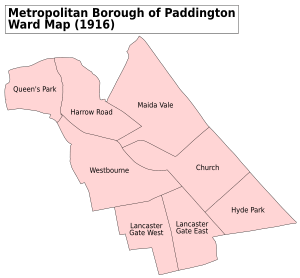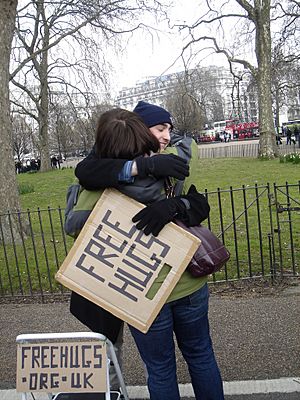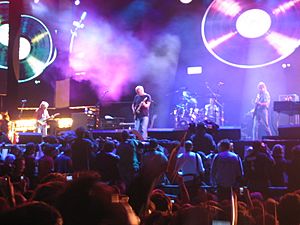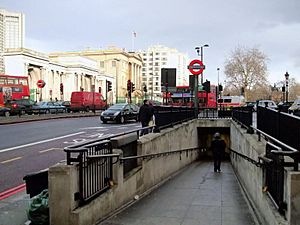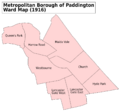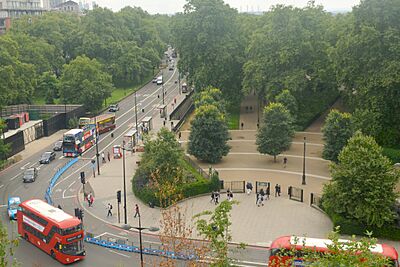Hyde Park, London facts for kids
Quick facts for kids Hyde Park |
|
|---|---|

Hyde Park, with Kensington Gardens in foreground
|
|
| Lua error in Module:Location_map at line 420: attempt to index field 'wikibase' (a nil value). | |
| Type | Public park |
| Location | Westminster, Greater London, England |
| Area | 350 acres (140 ha) |
| Created | 1637 |
| Operated by | The Royal Parks |
| Status | Open year-round |
| Website | |
| Official name | Hyde Park |
| Designated | 1 October 1987 |
| Reference no. | 1000814 |
Hyde Park is a huge, historic park in central London, England. It's one of London's special "Royal Parks" and covers about 350 acres (142 hectares). This makes it one of the largest green spaces in the city. It connects to other famous parks like Kensington Gardens and Green Park, leading all the way to Buckingham Palace. Two beautiful lakes, the Serpentine and the Long Water, divide Hyde Park.
King Henry VIII created the park in 1536 as a hunting ground. It opened to the public in 1637 and quickly became a popular spot. In the 1700s, Queen Caroline made many improvements. Later, in 1851, the famous The Great Exhibition was held here, featuring the amazing The Crystal Palace building.
Hyde Park is also well-known for free speech and protests. Speakers' Corner has been a place for public debate since 1872. Many important groups, like the suffragettes (who fought for women's right to vote), have held protests in the park. In recent times, Hyde Park has hosted huge free rock concerts with bands like Pink Floyd and The Rolling Stones. Big events like Live 8 and the annual Hyde Park Winter Wonderland continue to draw crowds.
Contents
Hyde Park: London's Famous Green Space
Hyde Park is a special "Royal Park" right in the heart of London. It has busy roads on its sides, like Bayswater Road to the north and Park Lane to the east. To the west, Hyde Park joins up with Kensington Gardens. These two parks look like one big green space during the day. However, Kensington Gardens closes at sunset, while Hyde Park stays open from 5 AM until midnight all year.
Hyde Park covers about 142 hectares (350 acres). Kensington Gardens adds another 111 hectares (274 acres). Together, they form a massive green area in London. This park has been recognized as a Grade I listed historic park since 1987.
A Look at Hyde Park's History
How Hyde Park Began
King Henry VIII created Hyde Park in 1536. He took the land from Westminster Abbey to use it as his private hunting ground for deer. For many years, it remained a private area for royalty.
Later, King James I allowed some people to visit the park. Then, in 1637, King Charles I opened Hyde Park to everyone. This made it one of the first public parks in the world.
During a time when England had no king (the Interregnum), the park was sold. It was bought for £17,000, which was a lot of money back then!
Royal Changes and Big Events
When King William III moved to Kensington Palace in 1689, he built a special road across the park. This road, now called Rotten Row, was his private path. In the late 1800s, wealthy people used it for horseback rides.
Queen Caroline made the park much more beautiful in the early 1700s. She oversaw the creation of the Serpentine lake by damming a small stream. The Serpentine is now divided from the Long Water by a bridge built in 1826.
One of the most important events in the park's history was The Great Exhibition of 1851. A huge glass building called The Crystal Palace was built for it. After the exhibition, the Crystal Palace was moved to another part of London.
On June 26, 1857, Queen Victoria held the first Victoria Cross awards ceremony in the park. She honored 62 brave soldiers.
Sadly, on July 20, 1982, two bombs exploded in Hyde Park and another park. This tragic event caused the death of eight soldiers and seven horses.
Exploring Hyde Park's Features
Famous Entrances and Arches
In the late 1700s, people wanted a grander entrance to Hyde Park. The current main entrance at Hyde Park Corner was designed by Decimus Burton in the 1820s. He also designed the Wellington Arch.

The Wellington Arch was originally part of the park's entrance. It was moved in 1883. Today, you can visit the arch and enjoy views of the parks from its top.
Special Spots to See
Hyde Park has many interesting places to visit:
- Speakers' Corner is in the northeast corner. It's famous for public debates.
- Rotten Row is a historic path used for horseback riding.
- The Diana, Princess of Wales Memorial Fountain is a beautiful stone fountain opened in 2004.
- London's Hyde Park Holocaust Memorial is a quiet place for remembrance.
- The 7 July Memorial honors the victims of the 2005 London bombings.

You can also find unique sculptures around the park. These include Still Water (a giant horse head) and Jelly Baby Family (giant jelly babies!). There's also a lovely rose garden added in 1994.
Free Speech and Protests
Speakers' Corner: A Place for Ideas
Speakers' Corner in Hyde Park is known worldwide for allowing free speech. People can come here to share their ideas and debate different topics. In 1855, a large protest happened here against a law that would ban Sunday trading.
In 1867, the police took over managing the park. This was partly because of the potential for large crowds at Speakers' Corner. The Parks Regulation Act 1872 made rules for park keepers and police in royal parks.
Speakers' Corner became very popular in the late 1800s. People would bring signs, ladders, and boxes to stand on so they could be seen and heard. It was also common for people to shout questions or comments at the speakers. Today, with the rise of the internet, it's seen more as a tourist attraction.
Big Protests in the Park
Besides Speakers' Corner, Hyde Park has hosted many important protests.
- In 1886, the Reform League marched to the park to demand more voting rights. Even though the police closed the park, the crowd broke through the fences. This event was called "The Hyde Park Railings Affair."
- On June 21, 1908, about 750,000 people marched to Hyde Park for "Women's Sunday." They were protesting for women's right to vote.
- In 2002, a large protest against the 2003 invasion of Iraq took place in Hyde Park.
- On February 15, 2003, over a million people gathered in Hyde Park as part of a global protest against the Iraq War.
Music and Concerts in Hyde Park
Rock Legends and Huge Crowds
The bandstand in Hyde Park was built in 1869. It became a popular spot for concerts in the 1890s. Military and brass bands often played there.
In 1968, the first rock concert was held in Hyde Park. Bands like Pink Floyd and Jethro Tull played to 15,000 people. Many famous bands have played here since then.
- Blind Faith, a supergroup with Eric Clapton, played their first show here in 1969.
- The Rolling Stones played a huge concert in 1969, just after their band member Brian Jones passed away. This is one of the most famous concerts of the 1960s.
- Queen played a free concert in 1976. Between 150,000 and 200,000 people attended, which is still the biggest crowd for a Hyde Park concert!
Modern Concerts and Events
The British Live 8 concert took place in Hyde Park on July 2, 2005. This event was organized to raise awareness about poverty in poorer countries. Many famous artists performed, including U2, Coldplay, Elton John, and Paul McCartney. The most anticipated performance was Pink Floyd reuniting for the first time in many years. This was their final live show.
In 2012, Hyde Park hosted a concert for the opening ceremony of the 2012 Summer Olympics. Bands like Duran Duran and Stereophonics performed. Since 2011, Radio 2 Live in Hyde Park has been an annual event. The British Summer Time concert series has also taken place every summer since 2013.
Some local residents have complained about the noise from concerts. In 2012, the microphones for Bruce Springsteen and Paul McCartney were even turned off because they played past the allowed time.
Sports and Activities
Hyde Park offers many ways to stay active! It has several football pitches and a Tennis center. There are also many paths for cycling. Horse riding is also a popular activity in the park.
For the 2012 Summer Olympics, Hyde Park hosted the triathlon and the 10 km open water swimming events. British brothers Alistair Brownlee and Jonathan Brownlee won gold and bronze medals in the triathlon.
Getting to Hyde Park
Hyde Park is easy to reach by public transport. Several London Underground stations are located on or near the park's edges:
- Hyde Park Corner tube station (Piccadilly line)
- Knightsbridge tube station (Piccadilly line)
- Queensway tube station (Central line)
- Lancaster Gate tube station (Central line)
- Marble Arch tube station (Central line)
Other nearby stations include Bayswater tube station and High Street Kensington tube station. Paddington station, a major train station, is also a short walk away.
Main roads run around the park, including Park Lane. For visitors who have trouble walking, "Liberty Drives" offers free transport within the park.
A special Cycle Superhighway 3 (CS3) starts at Lancaster Gate. This route allows cyclists to ride safely through the park, separated from other traffic.
Images for kids
-
Decimus Burton's Grand Entrance to Hyde Park at Hyde Park Corner.
-
Decimus Burton's Wellington Arch near Hyde Park Corner.
-
The 7 July Memorial in Hyde Park.
-
Pink Floyd performing at Live 8 in Hyde Park in 2005.
See also
 In Spanish: Hyde Park para niños
In Spanish: Hyde Park para niños



